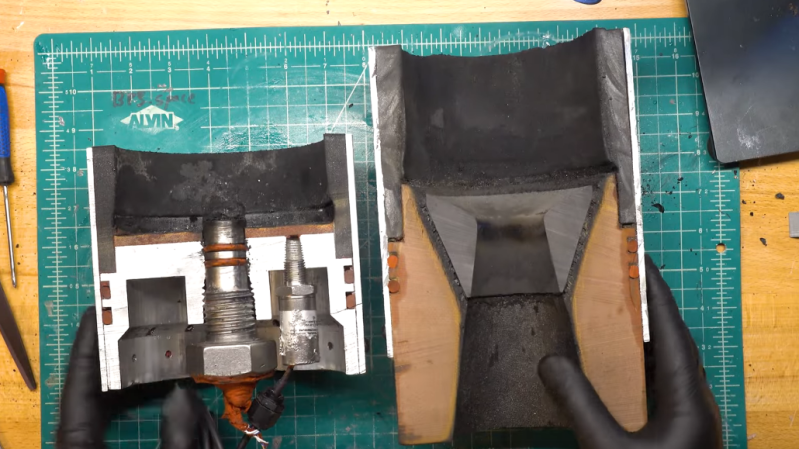[Joe Barnard] made a solid propellant rocket motor, and as one does in such situations, he put it through its paces on the test stand. The video below is not about the test, nor is it about the motor’s construction. Rather, it’s a deconstruction of the remains of the motor in order to better understand its design, and it’s pretty interesting stuff.
Somewhere along the way, [Joe], aka “BPS.Space” on YouTube, transitioned from enthusiastic model rocketeer to full-fledged missile-man, and in the process stepped up his motor game considerably. The motor that goes under the knife — or rather, the bandsaw — in this video is his “Simplex V2,” a completely DIY build of [Joe]’s design. For scale, the casing is made from a 6″ (15 cm) diameter piece of aluminum tubing over a meter in length, with a machined aluminum forward closure and a composite nozzle assembly. This is a pretty serious piece of engineering.
The closure and the nozzle are the focus of the video, which makes sense since that’s where most of the action takes place. To understand what happened during the test, [Joe] lopped them off and cut them roughly in half longitudinally. The nozzle throat, which was machined from a slug of graphite, fared remarkably well during the test, accumulating only a little slag from the propellant, a combination of powdered aluminum, ammonium perchlorate, and HTBP resin. The lower part of the nozzle, made from phenolic-impregnated linen, did pretty well too, building up a pyrolyzed layer that acted much like a space capsule’s ablative heat shield would. The forward closure, whose sole job is to contain the inferno and direct the exhaust anywhere but up, took more of a beating but stood up to the challenge. Especially interesting was the state of the O-rings and the way that the igniter interfaced with the closure.
Post mortems like these are valuable teaching tools, and while it must be heartbreaking to destroy something you put so much work into, you can’t improve what you can’t measure. Hats off to [Joe] for the peek inside his world.















Might be a good idea to add a disclaimer that this is illegal in some countries like the UK, as it’s classed as manufacturing explosives.
This is an ongoing series, he went in depth in a prior video about some of the nature of building such devices, how he keeps certain procedures out altogether, and the legal framework around how the difference between an amateur rocket and a missile is sometimes a fine line, especially internationally.
There’s loads of stuff on youtube that is illegal somewhere
If you just do any old thing you see on the internet, the Darwin award will probably get you before the law does.
In the US special licensing is required to build and fly rockets that are larger than small hobby size if my memory of why a friend got out of the hobby
My friend and I got tired of chasing down our model rocket, so I just taped some cardboard fins directly to a D engine and launched it. It went right through a neighbor’s window screen and nothing more was heard about it.
Since the house didn’t burn down (and we did keep watch on that window for a while), I can still laugh when imagining the neighbor’s reaction to finding this mystery cylinder in a room hours, days, or years later.
Joe has done an unbelievably good job on everything he has worked on toward all of this. He’s not an engineer but does have a degree in music, or sound, or something like that so he has a technical mind for sure. It blows me away at how resilient he has been having some real ups and downs along the way and ultimately coming out super successful in the end. His data collecting and processing is also quite good. He’s got a real knack for this stuff and I wish him the best with it all.
Joe may not have an engineering degree but there is no doubt in my mind that he is in fact an engineer.